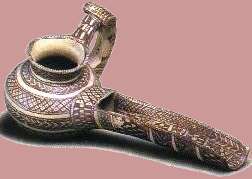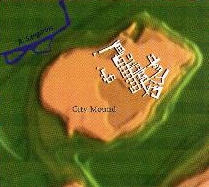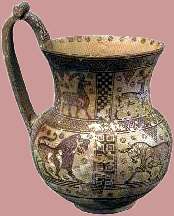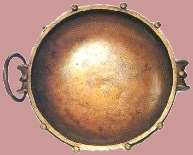Gordion is situated on a low flat mound called Yassihoyuk, on the east bank of the Sakarya (Sangarios) river, north of its confluence with the Porsuk (Tembris). The site was first investigated by the Korte brothers in 1900, and from 1950 Was excavated by the Pennsylvania University Museum Expedition under the directorship of Rodney Young, until his tragic death in 1974. Since then, the expedition has been led by Kenneth Sams and Mary Voigt.

Sieve-spouted jug, baked clay
|

Gordion looking north, and the Phyrigian level of the City Mound.
The name of the city is clearly related to the name Gordios, the first king of the Phrygians, but the relationship has not been conclusively explained. Whether the king gave his name to the city, or his own name was invented from the city's name, will perhaps never be known. The name Midas, son of Gordios, is also controversial and may be a generic name for 'king' rather than referring to a specific king or kings.
|
|
The site is a strongly fortified citadel, with a monumental gateway 9 m. wide and 23 m. deep, approached by a passageway and ramp designed to discourage attackers, who would be at the mercy of defenders placed strategicdly on the walls above. The focal point of the citadel was a royal palace within a separate enclosure system. The buildings were constructed on the megaron plan, which is characterized by a large inner room, fronted by a porch or anteroom roughly half the length of the main room. There was usuafly a hearth in either the main room or the porch, and sometimes in both. That the megaron roofs were gabled is indicated by the pitched roof of the Great Tumulus (MM) and graffiti drawn on the walls of one of the megara, Megaron II. The archaeological evidence for the construction of the roofs, timber beams covered by reeds and clay, was excavated in the bumt destruction levels. The doodling on the walls of Megaron II includes human figures, animals and birds, and agricultural implements, as well as the gabled houses.
|

Round mounted jug, baked clay
|

Bowl with swivelling ring handles
and rim bans, bronze
|
This megaron also provides an early example of a polychrome pebble mosaic, the dark blue, dark red and white pebbles creating a series of scattered geometric designs. Geometric motifs were also favoured for Phrygian painted pottery of the 8th century. The large Megaron III, immediately to the west of Megaron II, was divided internally into a nave and two aisles and seems to have had a wooden gallery mnning around the rear wall and the two side walls. The contents of this building were preserved by the conflagration dated to the early 7th century, and include fragments of carved wooden furniture with ivory inlay, bronze and ceramic vessels, and traces of burnt textiles, the implied luxury suggesting that this was the residence of the Phrygian king, or of some other royal or aristocratic personage.
|
The so called Terrace Building is on a terrace to the south, and comprises eight contiguous megara, all apparently with wooden gafleries as in Megaron III. The importance of the megara of the Terrace Building is the evidence they provide for domestic activities connected with the palace complex, finds of burnt wheat and barley, domestic cooking pots, grinding stones, loom weights, and ovens and hearths in the outer rooms, testifying overall to operations relating to grinding, baking, cooking and weaving, and use as storage rooms. In two of the rooms were carved ivory horse-trappings, bronze animal figurines, large bronze vessels, and gold and electrum jewellery.

A hoard of 44 Lydian coins dating to the end of the 7th and beginning of the 6th century BC, found in 1963 at Gordion.
|
The cemetery, to the northeast and southeast of the mound, is represented by over 80 tumuli, dating from the Phrygian to the Galatian periods (8th to 1st centuries BC). The largest of these (Tumulus MM, or the Great Tumulus) is believed to represent the tomb of King Midas.
The objets from the tumulus burials, which were excavated intact, and those items which were retrieved from the burned remains of the palace megara, demonstrate that Phrygian art of the 8th and early 7th century reflects a combination of traditions, including influences from the East (Urartu, Assyria, Iran, North Syria and Phoenicia) and from Greece, perhaps via the East Greek cities, which in turn were receptive to Phrygian ideas. Most striking, however, is an innovative style in which can also be detected a mastery of the art of metalworking on a par with that of their Urartian neighbours.
|
|











